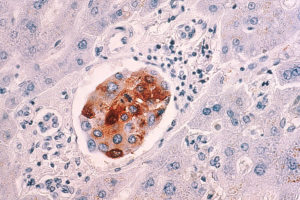Good news in the fight against cancer: Death rates from the disease — the second biggest killer in the United States — are the lowest they’ve been in over two decades.
According to a new report from the American Cancer Society, the cancer death rate has dropped 25 percent since 1991, meaning about 2.1 million fewer cancer deaths between 1991 and 2014.
The new report also estimates that in 2017, there will be 1,688,780 new cancer cases and roughly 600,920 cancer deaths in the U.S.

This staggering drop is due to decreasing death rates in the four largest types of cancer: lung, breast, prostate and colorectal. The authors of the study believe that this may be because of a drop in smoking, which was responsible for about 30 percent of all cancer deaths, as well as advances in treatment and early detection.
Related: This Breathalyzer Could Be Used to Detect Cancer
“It’s pretty exciting for us that the cancer death rate continues to decline,” said Rebecca Siegel, strategic director of surveillance information services at the American Cancer Society and lead author of the annual report, which was published in CA: A Cancer Journal for Clinicians. “We’re making a lot of progress.”
The new report highlighted large gender disparities in cancer diagnosis and mortality rates. Cancer incidence rate is 20 percent higher in men than it is in women, and the overall cancer death rate is 40 percent higher in men.

“There’s a different mix of cancers in men and women, and a lot of it has to do with differences in exposure to cancer risk factors,” Siegel said.
The large gender gap is a reflection of several factors. For example, liver cancer — a particularly fatal cancer — is three times more common in men than women. This is because, historically, men have a higher smoking rate, are more prone to excess alcohol consumption and have a higher rate of Hepatitis C virus infection. Also, melanoma rates are about 60 percent higher in men, and the death rates from melanoma are more than double in men compared to women.
Related: Jet Lag May Increase Your Risk of Liver Cancer
Traditionally, minorities have died at a higher rate from cancer, but those numbers have dropped, too. For instance, in 1990 black men were nearly 50 percent more likely to die from cancer than white men, but in 2014 the difference in the cancer death rate dropped to 21 percent. Experts say this is due to more access to healthcare and insurance — the number of uninsured Blacks and Hispanics dropped in half from just 2010 to 2015.
Medical professionals and scientists remain increasingly hopefully over further decreasing the cancer death rate.
The continuing drops in the cancer death rate are a powerful sign of the potential we have to reduce cancer’s deadly toll,” said Otis W. Brawley, M.D., FACP, chief medical officer of the ACS. “Continuing that success will require more clinical and basic research to improve early detection and treatment, as well as creative new strategies to increase healthy behaviors nationwide. Finally, we need to consistently apply existing knowledge in cancer control across all segments of the population, particularly to disadvantaged groups.”
Danielle Tarasiuk is a multimedia journalist based in Los Angeles. Her work has been published on AllDay.com, Yahoo! Sports, KCET, and NPR-affiliate stations KPCC and KCRW. She’s a proud Sarah Lawrence College and USC Annenberg alumn.


![How To: ‘Fix’ Crepey Skin [Watch]](https://cdn.vitalupdates.com/wp-content/uploads/2017/05/bhmdad.png)












